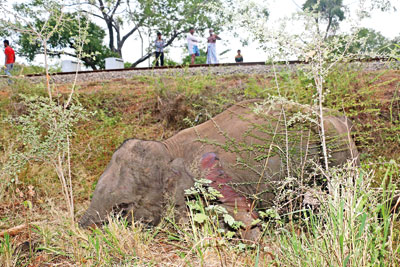News
Key elephant-train solutions derailed
The government has begun implementing parts of a proposal aimed at preventing elephants from being killed by passing trains, but some key recommendations have been put on hold.

The tragic scenes of jumbo deaths in Habarana
Railways Department General Manager Dilantha Fernando said environmental groups claimed they could come up with better solutions at cheaper rates than the proposals set out in a report released last month by a committee of officials from the railways and wildlife departments.
“Now we have too many experts saying that they will do better research and come up with better solutions, so the Transport Minister decided to withhold the decision to seek Cabinet approval and start installing the sensor system,” Mr. Fernando said.
A sensor system that would keep elephants away from lines by emitting low-frequency sound waves and also alert oncoming trains to the presence of elephants near tracks is a key part of the recommendations by the committee.
Mr. Fernando said the Minister will call for tenders through newspaper advertisements and consider other options as well, and this meant the use of a sensor system would be delayed.
He said there was no money to implement the committee’s recommendation that tunnels and overhead passes be constructed to let elephants cross safely under or over tracks depending on topography.
“On Friday, I ordered employees to clear a 30-feet stretch alongside the tracks. The area we clear must be maintained to be without any growth of grass that elephants feed on,” Mr. Fernando said.
He said the railways department was trying to source a locomotive headlight that could illuminate the track at least 300m ahead.
“We have also advised engine drivers to slow down their trains before they reach crossing places used by elephants over the rail tracks,” Mr. Fernando said.
Environmentalist Shashikalana Ratwatte believes there are 30 major elephant crossing points on the northern and Batticaloa lines and said he and colleagues Nayanaka Ranwella and Dimuthu Lokuge want to determine why elephants use these particular transit places and where these routes lead.
Mr. Rathwaththa complained that although the wildlife department had erected warning signs at well-known elephant transit points on tracks and suggested a 10-mile speed limit at these sites, engine drivers failed to obey the signs.
He said that at a recent meeting, train drivers told him they could not deviate from the timetables imposed on them.
“The railway must oblige the Department of Wildlife Conservation’s requests and signs. Both trains and elephants are public property and must be preserved,” Mr. Ratwatte said.
Farmers’ organisations say poor management of most national parks was causing elephants to travel out of parks and forestry areas.
The National Organiser of the All-Island Farmers’ Federation (AIFF), Namal Karunaratne, said elephants had expanded their home ranges in search of water and food, crossing railway tracks to enter villages and cultivated areas.
He said the Department of Wildlife Conservation must create more tanks and maintain grasslands within parks; elephants had insufficient water or “beru thana” – a type of grass that elephants prefer to eat.
Mr. Karunaratne also pointed out that there was encroachment by both large and small-scale plantation companies and factories along the northern and Batticaloa railway lines have seen, and these developments had barricaded the paths used by generations of elephants.
“Elephants have nowhere to go. Inside parks they are starving without food. Outside parks, their lands are encroached and secured with barbed wire and high-powered electric fences. The small thickets of forests are shrinking and they are trapped between villages and railway tracks,” he said.
He said animals were often hit by passing trains as they crossed tracks in order to reach safety in the forest when they were chased away by villagers and farming companies.
DWC Director-General Chandana Sooriyabandara said the wildlife department could play no role other than supporting the railway department’s actions since the recommendations involved solutions that were in railways territory. Improvements to locomotives, changing speed limits and constructing elephant passes across tracks could only be implemented by the railways department.
The committee’s report does, however, include recommendations on actions that should be taken by both the forestry and wildlife departments.
There were proposals to create water sources and tanks and maintain shrubbery needed by elephants for food within wildlife parks to keep jumbos well fed in their natural habitat so that they would not migrate out of parks.
The report also proposed that the DWC remove its own electric fences and those erected by private hands that form barriers across elephant paths that avoid railway tracks.
| Bees make elephants buzz off | |
| Vicky Flynn, Head of Communications for Elephant Family, a non-governmental organisation engaged in conservation of elephants, described projects going on around Asia that use bee sounds to scare elephants away from railway tracks. She said in India, recordings of sounds of bees, bats, lions and tigers are used to scare away elephants when they come too close to tracks. She said it was upsetting to hear the number of mothers and calves killed on railway tracks in Sri Lanka and pointed out that efforts could be made to clean up food garbage tossed out of trains that could be attracting elephants to the tracks. |

